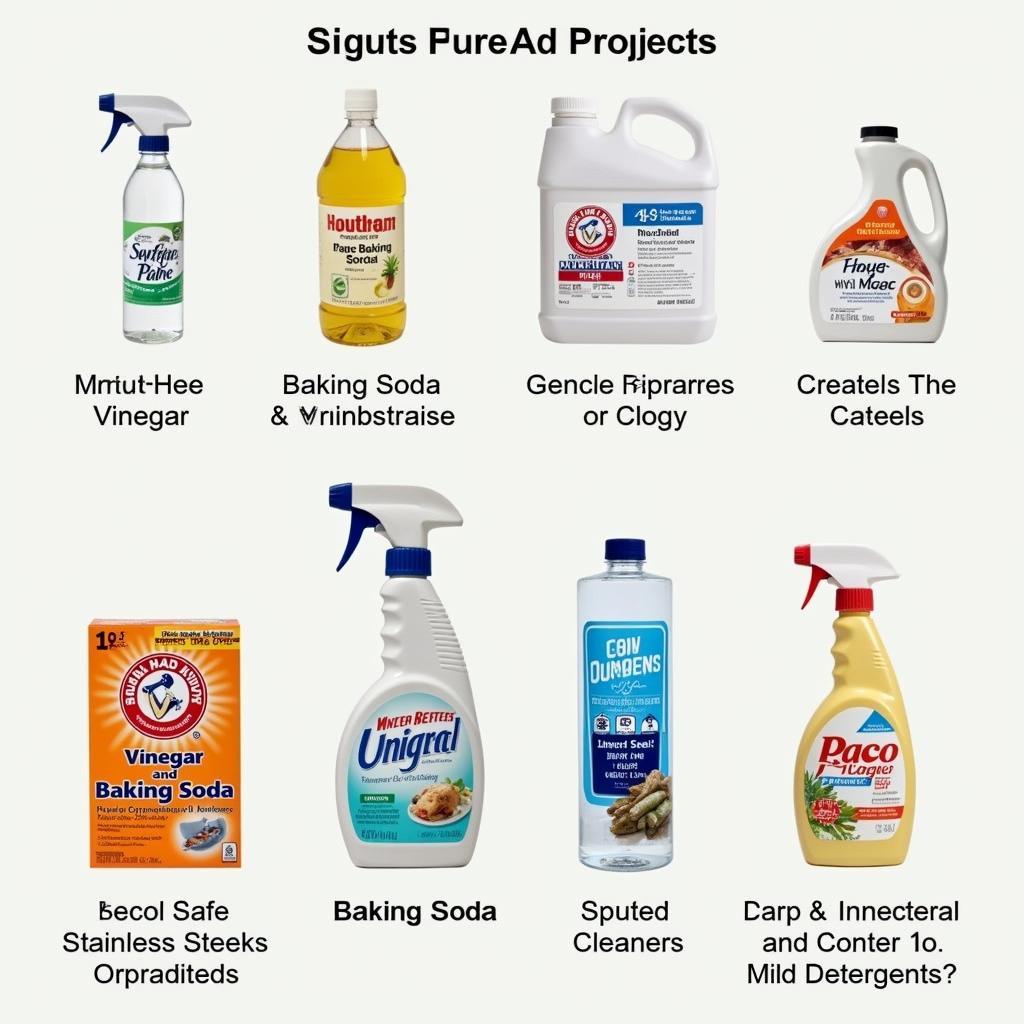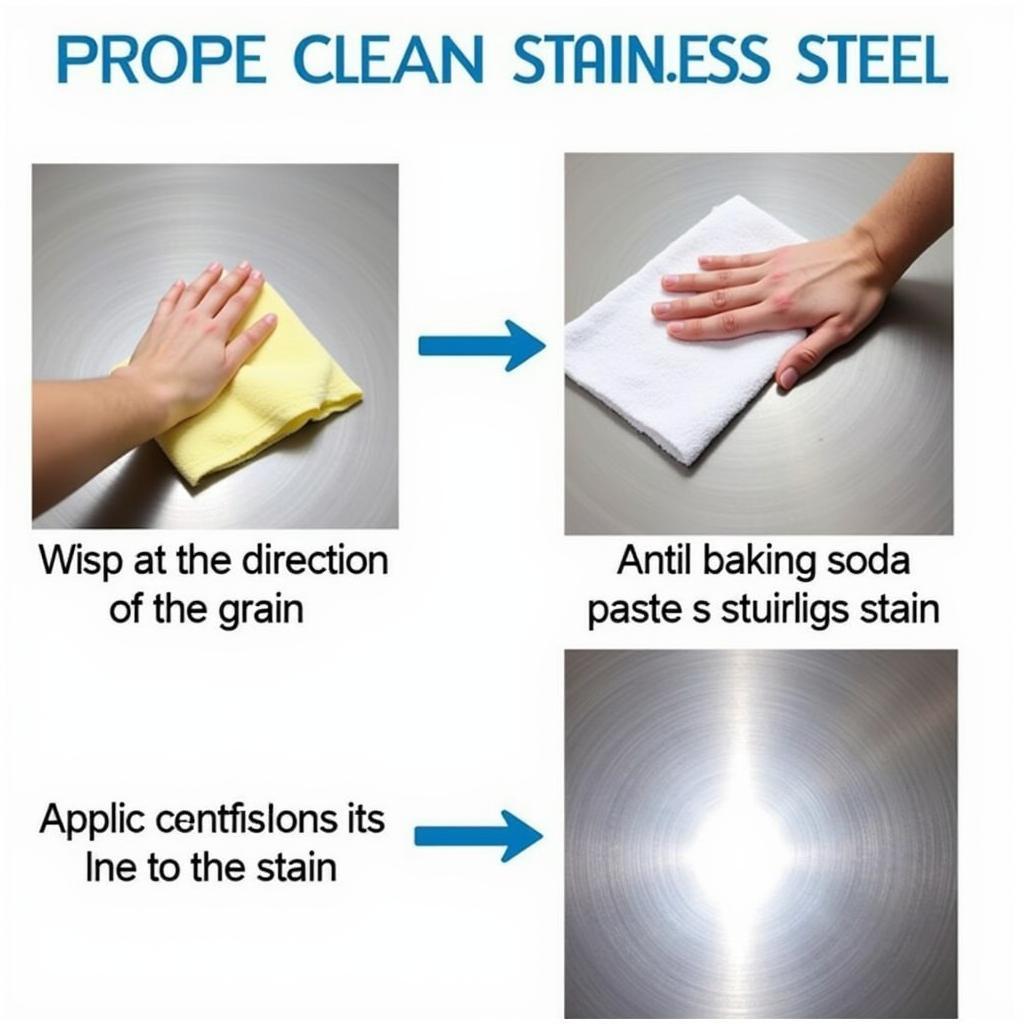Keeping your stainless steel sparkling clean is essential, especially when it comes to food preparation surfaces. Using a Food Safe Stainless Steel Cleaner is the key to ensuring both hygiene and the longevity of your valuable kitchen equipment. This guide dives deep into everything you need to know about choosing, using, and maximizing the effectiveness of these crucial cleaning products.
Why Food Safe Stainless Steel Cleaner Matters
Stainless steel is a popular choice for kitchens due to its durability and resistance to corrosion. However, even this robust material requires proper care to prevent rust, staining, and the buildup of harmful bacteria. Regular cleaning with a dedicated food safe stainless steel cleaner ensures a pristine surface, free from contaminants that can compromise food safety. Have you ever considered the potential hazards lurking on a poorly cleaned cutting board? Using the right cleaner eliminates these worries, allowing you to focus on creating delicious and healthy meals. Check out our range of food tray stainless to see how beautiful and functional clean stainless steel can be.
Choosing the Right Food Safe Stainless Steel Cleaner
With so many cleaning products on the market, selecting the right one can feel overwhelming. Look for cleaners specifically labeled as “food safe” or “NSF certified.” These designations guarantee that the product is safe for use on surfaces that come into contact with food. Avoid harsh chemicals like bleach, which can damage the stainless steel and leave behind harmful residues. Opt for gentle, yet effective formulas that remove grease, grime, and fingerprints without compromising the integrity of the material. Need a reliable solution for your food storage? Consider a commercial food storage container.
Deciphering Ingredient Lists
Understanding the ingredients in your cleaner is crucial for informed decision-making. Natural cleaners often utilize ingredients like vinegar or baking soda, offering a safe and eco-friendly alternative. However, for tougher stains and baked-on food, specialized stainless steel cleaners may contain mild detergents or surfactants. Always read the label carefully and ensure the product is appropriate for your specific needs.
 Food Safe Stainless Steel Cleaner Ingredients
Food Safe Stainless Steel Cleaner Ingredients
Cleaning Techniques for Sparkling Stainless Steel
Proper cleaning technique is just as important as the cleaner itself. Always wipe in the direction of the stainless steel’s grain to prevent streaks and scratches. Avoid abrasive sponges or scouring pads, as these can damage the surface. A microfiber cloth or soft sponge is ideal for gentle yet effective cleaning. For stubborn stains, consider creating a paste of baking soda and water, applying it to the affected area, and letting it sit for a few minutes before wiping clean. Even our food carriers benefit from this gentle cleaning method.
How Often Should You Clean?
Ideally, stainless steel surfaces should be cleaned after each use to prevent the buildup of grime and bacteria. However, for less frequently used items, a weekly cleaning is usually sufficient. Regular cleaning, combined with a quality food grade stainless steel cleaner, will keep your stainless steel looking its best.
 Stainless Steel Cleaning Techniques
Stainless Steel Cleaning Techniques
Maintaining Your Stainless Steel’s Shine
Beyond regular cleaning, there are a few extra steps you can take to maintain the shine of your stainless steel. After cleaning, rinse thoroughly with clean water and dry immediately to prevent water spots. For an extra sparkle, consider using a stainless steel polish. These polishes help to remove fingerprints and create a protective barrier against future stains. Just as you’d care for your cat food bowl stand, proper maintenance is key for long-lasting beauty.
Expert Advice from Maria Hernandez, Certified Food Safety Specialist
“Using a food safe stainless steel cleaner is not just about aesthetics; it’s about protecting your health. Harmful bacteria can thrive on improperly cleaned surfaces, leading to foodborne illnesses. Investing in a quality cleaner is an investment in your well-being.”
Expert Tip from Dr. James Lee, Materials Scientist
“Stainless steel is a remarkable material, but it still requires proper care. Harsh chemicals can corrode the surface and compromise its durability. Always choose a cleaner specifically formulated for stainless steel to ensure its longevity.”
Conclusion
Using a food safe stainless steel cleaner is essential for maintaining a hygienic and sparkling kitchen. By choosing the right cleaner and employing proper cleaning techniques, you can ensure the longevity of your stainless steel investments and protect your health. Regular cleaning with a food safe stainless steel cleaner is a simple yet effective way to elevate your kitchen and enjoy peace of mind.
FAQs
- What is the best food safe stainless steel cleaner?
- Can I use vinegar to clean stainless steel?
- How do I remove stubborn stains from stainless steel?
- What are the benefits of using a food safe cleaner?
- How often should I clean my stainless steel appliances?
- Can I use a regular all-purpose cleaner on stainless steel?
- How do I prevent water spots on stainless steel?
Common Scenarios and Questions:
- Scenario: Burned-on food residue on a stainless steel pot. Question: What’s the best way to remove this without scratching the surface?
- Scenario: Fingerprints all over the refrigerator. Question: What’s a quick and easy way to clean them off?
- Scenario: Rust spots on a stainless steel sink. Question: How can I prevent rust from forming in the future?
Further Exploration:
Check out our other articles on maintaining a clean and organized kitchen. You might also be interested in our guide to choosing the right food storage containers.
Need Help?
For any assistance or inquiries, please contact us at Phone Number: 02437655121, Email: [email protected] Or visit our address: 3PGH+8R9, ĐT70A, thôn Trung, Bắc Từ Liêm, Hà Nội, Việt Nam. We have a 24/7 customer service team.